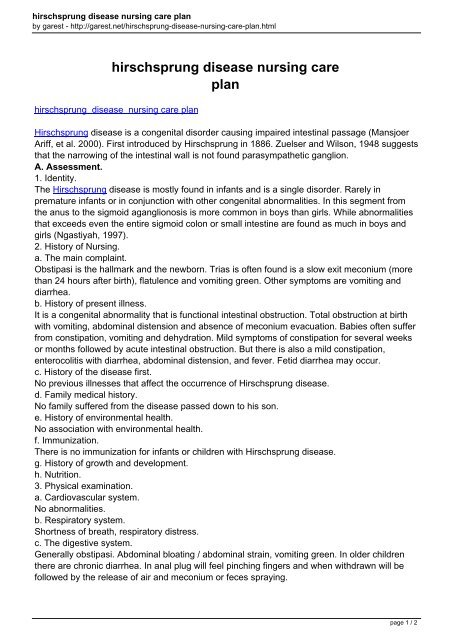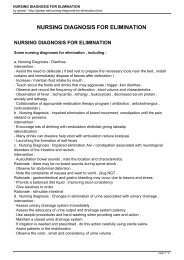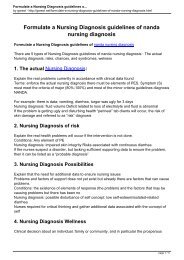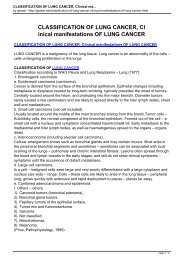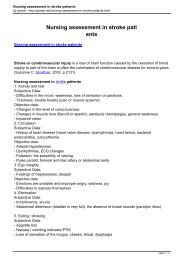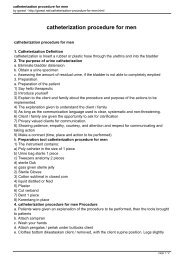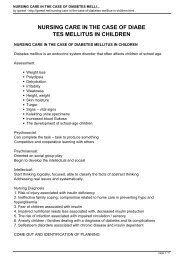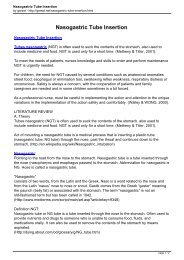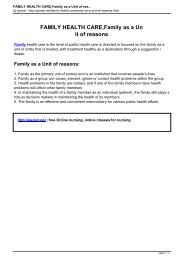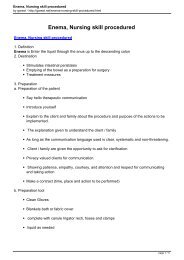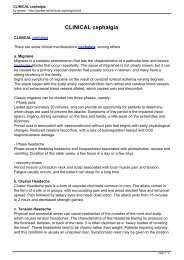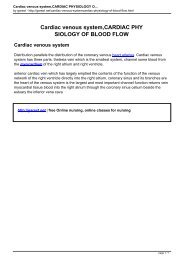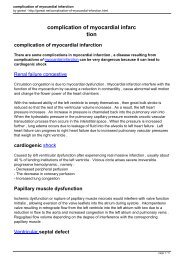hirschsprung disease nursing care plan
You also want an ePaper? Increase the reach of your titles
YUMPU automatically turns print PDFs into web optimized ePapers that Google loves.
<strong>hirschsprung</strong> <strong>disease</strong> <strong>nursing</strong> <strong>care</strong> <strong>plan</strong><br />
by garest - http://garest.net/<strong>hirschsprung</strong>-<strong>disease</strong>-<strong>nursing</strong>-<strong>care</strong>-<strong>plan</strong>.html<br />
<strong>hirschsprung</strong> <strong>disease</strong> <strong>nursing</strong> <strong>care</strong><br />
<strong>plan</strong><br />
<strong>hirschsprung</strong> <strong>disease</strong> <strong>nursing</strong> <strong>care</strong> <strong>plan</strong><br />
Hirschsprung <strong>disease</strong> is a congenital disorder causing impaired intestinal passage (Mansjoer<br />
Ariff, et al. 2000). First introduced by Hirschsprung in 1886. Zuelser and Wilson, 1948 suggests<br />
that the narrowing of the intestinal wall is not found parasympathetic ganglion.<br />
A. Assessment.<br />
1. Identity.<br />
The Hirschsprung <strong>disease</strong> is mostly found in infants and is a single disorder. Rarely in<br />
premature infants or in conjunction with other congenital abnormalities. In this segment from<br />
the anus to the sigmoid aganglionosis is more common in boys than girls. While abnormalities<br />
that exceeds even the entire sigmoid colon or small intestine are found as much in boys and<br />
girls (Ngastiyah, 1997).<br />
2. History of Nursing.<br />
a. The main complaint.<br />
Obstipasi is the hallmark and the newborn. Trias is often found is a slow exit meconium (more<br />
than 24 hours after birth), flatulence and vomiting green. Other symptoms are vomiting and<br />
diarrhea.<br />
b. History of present illness.<br />
It is a congenital abnormality that is functional intestinal obstruction. Total obstruction at birth<br />
with vomiting, abdominal distension and absence of meconium evacuation. Babies often suffer<br />
from constipation, vomiting and dehydration. Mild symptoms of constipation for several weeks<br />
or months followed by acute intestinal obstruction. But there is also a mild constipation,<br />
enterocolitis with diarrhea, abdominal distension, and fever. Fetid diarrhea may occur.<br />
c. History of the <strong>disease</strong> first.<br />
No previous illnesses that affect the occurrence of Hirschsprung <strong>disease</strong>.<br />
d. Family medical history.<br />
No family suffered from the <strong>disease</strong> passed down to his son.<br />
e. History of environmental health.<br />
No association with environmental health.<br />
f. Immunization.<br />
There is no immunization for infants or children with Hirschsprung <strong>disease</strong>.<br />
g. History of growth and development.<br />
h. Nutrition.<br />
3. Physical examination.<br />
a. Cardiovascular system.<br />
No abnormalities.<br />
b. Respiratory system.<br />
Shortness of breath, respiratory distress.<br />
c. The digestive system.<br />
Generally obstipasi. Abdominal bloating / abdominal strain, vomiting green. In older children<br />
there are chronic diarrhea. In anal plug will feel pinching fingers and when withdrawn will be<br />
followed by the release of air and meconium or feces spraying.<br />
page 1 / 2
Powered by TCPDF (www.tcpdf.org)<br />
<strong>hirschsprung</strong> <strong>disease</strong> <strong>nursing</strong> <strong>care</strong> <strong>plan</strong><br />
by garest - http://garest.net/<strong>hirschsprung</strong>-<strong>disease</strong>-<strong>nursing</strong>-<strong>care</strong>-<strong>plan</strong>.html<br />
d. Genitourinarius system.<br />
e. Nervous system.<br />
No abnormalities.<br />
f. Locomotor system / musculoskeletal.<br />
Impaired sense of comfort.<br />
g. The endocrine system.<br />
No abnormalities.<br />
h. Integumentary system.<br />
Akral warm.<br />
i. Auditory system.<br />
No abnormalities.<br />
4. Diagnostic tests and results.<br />
a. Plain abdominal upright will look dilated intestines or lower there is a picture of intestinal<br />
obstruction.<br />
b. With barium enema examination found the transition region, the picture intestinal<br />
contractions are not regular at the narrowing, widening enterocolitis in segments and there is<br />
retention of barium after 24-48 hours.<br />
c. Suction biopsy, looking for ganglion cells in the sub mucosa.<br />
d. Rectal muscle biopsy, which is taking rectal muscle layer.<br />
e. Examination of acetylcholine esterase enzyme activity where there is increased activity of<br />
the enzyme acetylcholine eseterase.<br />
B . <strong>nursing</strong> diagnoses that may appear in Hirschsprung <strong>disease</strong><br />
1. Elimination Disorders CHAPTER: obstipasi associated with spastic colon and absence of<br />
thrust.<br />
2. Alteration in nutrition less than body requirements related to the inadekuat intake.<br />
3. Lack of body fluids associated vomiting and diarrhea.<br />
4. Impaired sense of comfort associated with the presence of abdominal distension.<br />
5. Ineffective family coping related to the state of children’s health status.<br />
http://garest.net | free Online <strong>nursing</strong>, online classes for <strong>nursing</strong><br />
page 2 / 2


